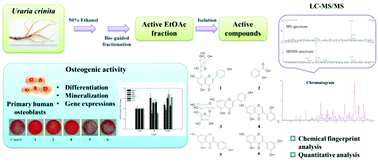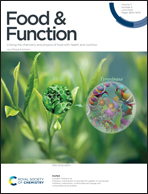Comprehensive LC-MS/MS-based phytochemical perspectives and osteogenic effects of Uraria crinita†
Abstract
Osteogenesis plays a vital role in the maintenance of bone health. Imbalances in osteogenesis influence the onset of several bone loss-associated diseases. The intake of Uraria crinita (Fabaceae) through dietary supplements is advised for childhood bone dysplasia. This botanical provides edible tonics and detoxifiers, and is also used as a folk beverage. We evaluated the osteogenic effects of a 50% ethanol extract of the root of U. crinita on primary human osteoblasts (HObs) and initiated a novel comprehensive phytochemical strategy using liquid chromatography-tandem mass spectrometry (LC-MS/MS) for quality control of this functional food. Two isoflavones, genistein (5) and 5,7-dihydroxy-3′,5′-dihydroxyisoflavone (6), increased the alkaline phosphatase activity (differentiation stage); the flavone glycoside vitexin (1), and the phenolic acid salicylic acid (2) enhanced the mineralization (mature stage). The isoflavone 2′-hydroxygenistein (4) possessed high osteogenic potential among the isolated compounds in HObs. It promoted osteogenesis-related stages and upregulated the gene expressions in a dose-dependent manner. The major compounds in the active fraction were quantitatively analyzed via phytochemical fingerprint detection. These LC-MS/MS-based phytochemical perspectives can act as reference standards in developing food supplements from U. crinita.



 Please wait while we load your content...
Please wait while we load your content...